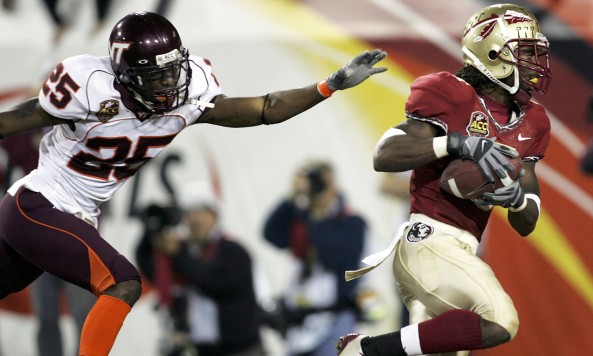In one of the more dramatic finishes of the BCS era, Kelvin Benjamin’s 2-yard touchdown grab against Auburn gave Florida State its first national championship in 14 years. After what some consider a lost decade, Florida State’s rise back to the top of college football was a long, arduous journey. The Seminoles endured three six-loss seasons, an academic cheating scandal and the forcing out of a legend that built the program.
In what will be a 10-part series, we take a look back on events that led to Florida State’s resurgence back to the top of the college football world. After finishing in the top 5 every year from 1987 until 2000, the Seminoles went 13 years without winning a major bowl game. The countdown’s order is mostly chronological rather than in terms of importance. The series kicked off with the hiring of Jimbo Fisher and resumed with the strong finish to end the Bobby Bowden era. In the third of a 10-part series on how Florida State returned to college football prominence, we look at the fact that FSU maintained a championship atmosphere.
During what some refer to as a lost decade for Florida State, three, four, five and even six losses in a season had become routine. Despite that, a return to the higher ranks of college football never really seemed that far away.
While legendary head coach Bobby Bowden was building the Florida State program into a national power, the university itself built some great football traditions as well. Though the drop-off over the lost decade was certainly noticeable, Tallahassee on gameday remained one of the great places to be throughout the country on Saturday.
In fact, it was during Florida State’s lost decade that Doak Campbell Stadium had eight of its 10 most attended games ever. The record of 84,347 that witnessed the Seminoles snap a six-game losing streak to Miami on Labor Day of 2005, remained for better than six years before it was topped in September of 2011.
Whether it was Chief Osceola planting the spear prior to the start of kickoff, great FSU players of the past paying visits, the Sod Cemetery or the 83,000 screaming fans at the state-of-the-art Doak Campbell Stadium, it was obvious that there was still something special about Florida State football. In a time that few Seminole fans look back on with fondness, Florida State was able to keep its intrigue and continued to be regarded as a national power.
Nationally televised contests and prime time appearances remained common for Florida State even during what some considered the worst of times. Labor Day match-ups against Miami drew large viewing audiences while contests against rival Florida and other elite programs made the raucous crowd at Doak Campbell Stadium come to life.
The team itself often underperformed, but the football facilities at Florida State remained second to none. During a time when revenues would be expected to stagnate, the university managed to erect new statues outside of Doak Campbell Stadium as well as expand the stadium itself. Prior to the start of the 2008 season, FSU put in two new high definition scoreboards which at the time, were among the biggest in America.
Despite the fact that losses had become much more common than in years past, the Seminoles were often able to rise to the occasion for a given contest. During the lost decade which ran from 2001 until 2009, FSU managed to defeat a ranked opponent every year.
The Seminoles never failed to capture a winning season over the stretch and during what seemed like a dark era, Florida State knocked off four top 10 opponents and won three ACC titles, including the inaugural ACC Championship. On that Jacksonville night in 2005, Florida State stunned fifth-ranked and 14-point favorite Virginia Tech, 27-22 in what remains one of the biggest upsets in program history.
Though the performance on the field hardly merited greatness, the great traditions, facilities and atmosphere kept top recruits coming. During a time when both rivals Miami and Florida won national championships, landing top 25 recruiting classes remained a given for the Seminoles. More often than not, Florida State held a top 10 class on National Signing Day despite many of its prized recruits having never watched the great FSU teams of the 1990s.
While playing for national championships had become a thing of the past, Florida State University remained a breeding pool for premier football talent. Stars like Brodrick Bunkley, Alex Barron and Kamerion Wimbley earned All-American honors during Florida State’s lost decade as others like Antonio Cromartie and Anquan Boldin were blossoming into All-Pro talents at the NFL level.
Thanks to a proud football tradition, a tremendous atmosphere, top notch facilities and the recruits that those things managed to land, it was only a matter of time before Florida State once again stood amongst college football’s elite. Over Florida State’s lost decade, years, players and opponents came and went. Following the 2009 season, a legendary head coach was replaced after 34 years.
Among all the changes that took place at FSU, the one constant was a championship caliber environment. As should be the case, that championship environment is once again watching its team play for championships.
Related Articles
Reasons for Seminole Resurgence: #9 2009′s Strong Finish
Reasons for Seminole Resurgence: #10 Hiring Jimbo Fisher




















